Talk:Half eagle
| This article is rated Start-class on Wikipedia's content assessment scale. It is of interest to the following WikiProjects: | ||||||||||||||||||||||||
| ||||||||||||||||||||||||
Needed is an explanation of the origin of the term "Half Eagle". James Hade (talk) 22:11, 3 January 2013 (UTC)
File:NNC-US-1795-G$5-Turban Head (heraldic eagle).jpg scheduled for POTD
[edit]Hello! This is to let editors know that the featured picture File:NNC-US-1795-G$5-Turban Head (heraldic eagle).jpg, which is used in this article, has been selected as the English Wikipedia's picture of the day (POTD) for June 14, 2021. A preview of the POTD is displayed below and can be edited at Template:POTD/2021-06-14. For the greater benefit of readers, any potential improvements or maintenance that could benefit the quality of this article should be done before its scheduled appearance on the Main Page. If you have any concerns, please place a message at Wikipedia talk:Picture of the day. Thank you! Cwmhiraeth (talk) 10:17, 24 May 2021 (UTC)
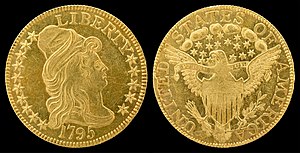
|
The half eagle is a United States coin that was produced for circulation from 1795 to 1929 and in commemorative and bullion coins since the 1980s. Made almost entirely of gold, it has a face value of five dollars. It was the first gold coin to be minted by the United States, authorized by the Coinage Act of 1792. Originally designed by Robert Scot, the design and composition of the half eagle has changed many times over the years. This half eagle, known as a "Turban Head", was minted in 1795 and is now part of the National Numismatic Collection. The coin's obverse depicts a personification of Liberty wearing a cap, while the reverse depicts a heraldic eagle. Other designs:Coin design credit: Robert Scot; photographed by Jaclyn Nash
Recently featured:
|

|
The half eagle is a United States coin that was produced for circulation from 1795 to 1929 and in commemorative and bullion coins since the 1980s. Composed almost entirely of gold, it has a face value of five dollars. It was the first gold coin to be minted by the United States, its production being authorized by the Coinage Act of 1792. The design and composition of the half eagle changed many times over the years, but it was originally designed by Robert Scot. This type was produced from 1795 to 1798; the obverse design depicts a turbaned portrait of Liberty facing to the right, and the reverse depicts a small eagle. Other designs:National Numismatic Collection, National Museum of American History; photographed by Jaclyn Nash
Recently featured:
|
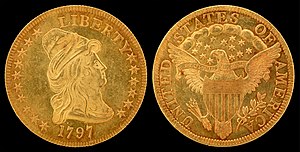
|
The half eagle is a United States coin that was produced for circulation from 1795 to 1929 and in commemorative and bullion coins since the 1980s. Composed almost entirely of gold, it has a face value of five dollars. It was the first gold coin to be minted by the United States, its production being authorized by the Coinage Act of 1792. The design and composition of the half eagle changed many times over the years, but it was originally designed by Robert Scot. The obverse design depicts a turbaned portrait of Liberty facing to the right, and the reverse depicts a heraldic eagle; this type was produced in 1797 and was unique in having 16 stars on the obverse. Other designs:National Numismatic Collection, National Museum of American History; photographed by Jaclyn Nash
Recently featured:
|

|
The half eagle is a United States coin that was produced for circulation from 1795 to 1929 and in commemorative and bullion coins since the 1980s. Composed almost entirely of gold, it has a face value of five dollars. It was the first gold coin to be minted by the United States, its production being authorized by the Coinage Act of 1792. The design and composition of the half eagle changed many times over the years, but this version was designed by John Reich and produced from 1807 to 1812. The obverse design depicts a round-capped portrait of Liberty facing to the left, and the reverse depicts a modified eagle. For the first time, "5 D." is included on the reverse to indicate the value of the coin. Other designs:National Numismatic Collection, National Museum of American History; photographed by Jaclyn Nash
Recently featured:
|
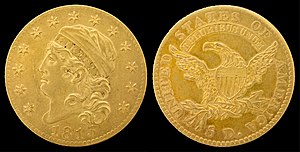
|
The half eagle is a United States coin that was produced for circulation from 1795 to 1929 and in commemorative and bullion coins since the 1980s. Composed almost entirely of gold, it has a face value of five dollars. It was the first gold coin to be minted by the United States, its production being authorized by the Coinage Act of 1792. The design and composition of the half eagle changed many times over the years, but this version was designed by John Reich and produced from 1813 to 1834. The obverse design depicts a round-capped portrait of Liberty facing to the left, and the reverse depicts a modified eagle. This type differs from its predecessor by Liberty having a larger head and a reduced bustline. Other designs:National Numismatic Collection, National Museum of American History; photographed by Jaclyn Nash
Recently featured:
|
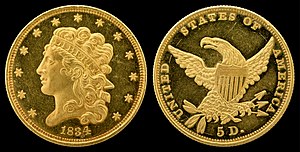
|
The half eagle is a United States coin that was produced for circulation from 1795 to 1929 and in commemorative and bullion coins since the 1980s. Composed almost entirely of gold, it has a face value of five dollars. It was the first gold coin to be minted by the United States, its production being authorized by the Coinage Act of 1792. The design and composition of the half eagle changed many times over the years, but this version was designed by William Kneass and produced from 1834 to 1838. The obverse design depicts a classic portrait of Liberty facing to the left, and the reverse depicts a modified eagle, with "E PLURIBUS UNUM" removed. Other designs:National Numismatic Collection, National Museum of American History; photographed by Jaclyn Nash
Recently featured:
|
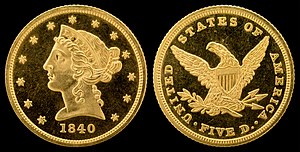
|
The half eagle is a United States coin that was produced for circulation from 1795 to 1929 and in commemorative and bullion coins since the 1980s. Composed almost entirely of gold, it has a face value of five dollars. It was the first gold coin to be minted by the United States, its production being authorized by the Coinage Act of 1792. The design and composition of the half eagle changed many times over the years, but this version was designed by Christian Gobrecht and produced from 1839 to 1866. The obverse design depicts a classic portrait of Liberty facing to the left, and the reverse depicts a modified eagle, with the value changed from "5 D." to "FIVE D.". Other designs:National Numismatic Collection, National Museum of American History; photographed by Jaclyn Nash
Recently featured:
|
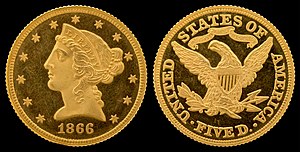
|
The half eagle is a United States coin that was produced for circulation from 1795 to 1929 and in commemorative and bullion coins since the 1980s. Composed almost entirely of gold, it has a face value of five dollars. It was the first gold coin to be minted by the United States, its production being authorized by the Coinage Act of 1792. The design and composition of the half eagle changed many times over the years, but this version was designed by Christian Gobrecht and produced in 1866. The obverse design depicts a portrait of Liberty facing to the left, and the reverse depicts a modified eagle, with the addition of the motto "IN GOD WE TRUST" above the eagle. Other designs:National Numismatic Collection, National Museum of American History; photographed by Jaclyn Nash
Recently featured:
|
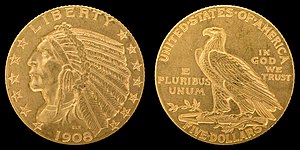
|
The half eagle is a United States coin that was produced for circulation from 1795 to 1929 and in commemorative and bullion coins since the 1980s. Composed almost entirely of gold, it has a face value of five dollars. It was the first gold coin to be minted by the United States, its production being authorized by the Coinage Act of 1792. The design and composition of the half eagle changed many times over the years, but this version was designed by Bela Pratt and produced from 1908 onwards. The obverse design depicts an Indian head wearing a feathered headdress facing to the left, and the reverse depicts a perched eagle with the inscriptions "E PLURIBUS UNUM" and "IN GOD WE TRUST". Other designs:National Numismatic Collection, National Museum of American History; photographed by Jaclyn Nash
Recently featured:
|

|
The half eagle is a United States coin that was produced for circulation from 1795 to 1929 and in commemorative and bullion coins since the 1980s. Composed almost entirely of gold, it has a face value of five dollars. It was the first gold coin to be minted by the United States, its production being authorized by the Coinage Act of 1792. The design and composition of the half eagle changed many times over the years, but this version was designed by John Reich and produced from 1813 to 1834. The obverse design depicts a round-capped portrait of Liberty facing to the left, and the reverse depicts a modified eagle. This 1822 coin is one of only three known for the year. National Numismatic Collection, National Museum of American History; photographed by Andrew Shiva
Recently featured:
|
- Start-Class United States articles
- Low-importance United States articles
- Start-Class United States articles of Low-importance
- WikiProject United States articles
- Start-Class numismatic articles
- Mid-importance numismatic articles
- Start-Class American currency articles
- Mid-importance American currency articles
- American currency articles
- WikiProject Numismatics articles



